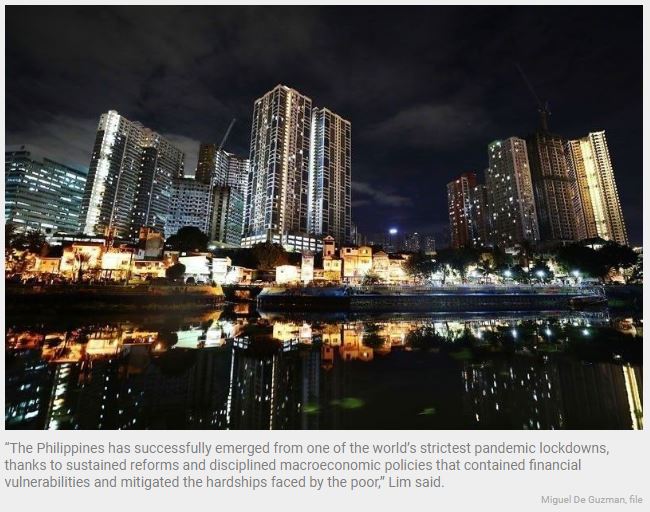IMF slashes Philippines growth forecasts
MANILA, Philippines — The International Monetary Fund sees the Philippines’ real gross domestic product (GDP) growing by 6.5 percent in 2022, but slowing to five percent in 2023 as global shocks weigh on the economy in the coming months, according to IMF mission head Cheng Hoon Lim.
“The Philippines has successfully emerged from one of the world’s strictest pandemic lockdowns, thanks to sustained reforms and disciplined macroeconomic policies that contained financial vulnerabilities and mitigated the hardships faced by the poor,” Lim said.
The country exited the pandemic-induced recession with a GDP expansion of 5.7 percent in 2021 after contracting by 9.6 percent due to the impact of the pandemic.
“Following a sharp contraction in 2020, the Philippine economy rebounded in late 2021 and accelerated further in the first half of 2022, spurred by strong domestic demand and private investment,” Lim said at a press conference.
The economy grew by 7.8 percent in the first half, faster than the 6.5 to 7.5 percent target set by the Development Budget Coordination Committee (DBCC).
“The Philippine economy remains fundamentally sound, but a gloomier and more uncertain global environment presents three important challenges for President Marcos’ new administration,” Lim noted.
She said inflation is expected to rise to 5.3 percent in 2022, and then decline modestly in 2023, supported by a moderation in commodity prices, and converge to the mid-point of the band in 2024, as tighter monetary policy keeps inflation expectations anchored.
Inflation averaged 4.9 percent from January to August, exceeding the two to four percent target set by the Bangko Sentral ng Pilipinas (BSP).
“The outlook is subject to significant downside risks, where policy tradeoffs between output and inflation would become more acute. Downside risks include a surge in COVID-19 cases from more severe variants, a more abrupt or larger-than-expected tightening of global financial conditions, a deepening of the global slowdown, persistently high domestic inflation and natural disasters,” she said.
On the upside, Lim said an end to Russia’s war in Ukraine and taming of inflation both domestically and globally could lay the foundations for stronger growth than currently envisaged.
“Looking ahead, sustaining the economic recovery will require a focus on policies to address inflationary risks, increase fiscal and financial resilience to adverse shocks, and successful implementation of reforms to mitigate pandemic scarring and raise productivity growth,” she said.
The IMF encouraged the BSP to provide clear communication about inflation, noting that BSP’s forward-looking policy intentions can help reduce uncertainty and improve policy transmission.
To tackle inflation, the BSP has raised interest rates by 225 basis points so far this year, bringing the overnight reverse repurchase rate to 4.25 percent from an all-time low of two percent.
Lim said strengthening the BSP’s capacity to assess financial stability risks, amending the bank secrecy law and strengthening the bank resolution framework can enhance supervision and resilience.
“Downside risks to growth and higher interest rates warrant close monitoring of financial stability risks, especially in sectors that are overleveraged. Remaining regulatory forbearance measures should be allowed to lapse,” Lim said.
Furthermore, she said that fiscal consolidation should be underpinned by stronger revenue mobilization and cost-effective government spending to secure the needed resources for the Philippines’ important social and development plans.
Meanwhile, S&P Global Ratings expects the Philippines to book a slower economic growth in the next three years with the expected slowdown in global demand serving as a big test for Asia-Pacific.
In a report, S&P lowered its 2022 GDP growth projections for the Philippines to 6.3 percent from the original target of 6.5 percent.
This is now lower than the revised 6.5 to 7.5 percent target set by the DBCC.
Likewise, the debt watcher lowered its GDP growth target to 5.7 percent from the original target of 6.6 percent for 2023 and to 6.4 instead of 6.9 percent in 2024. For 2025, it sees the Philippine economy growing by 6.3 percent.
S&P Asia-Pacific chief economist Louis Kuijs and economist Vishrut Rana said that the external environment has soured for Asia-Pacific economies.
“Following a solid 2022, Asia-Pacific’s growth outside China should soften in 2023 on high interest rate and weaker external demand,” the economists said.
Kuijs and Rana said S&P is expecting a larger slowdown in 2023 in South Korea and Taiwan than in India, Indonesia and the Philippines.
Source: https://www.philstar.com/business/2022/09/27/2212435/imf-slashes-philippines-growth-forecasts


 English
English




